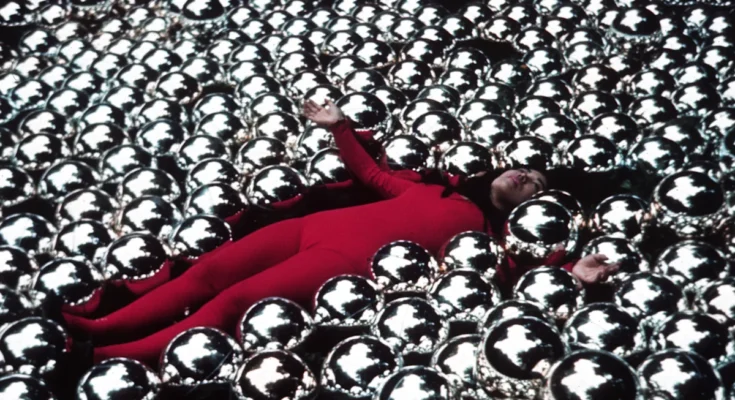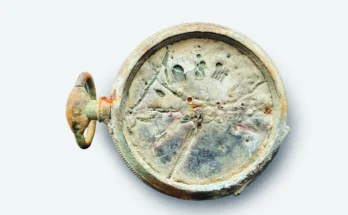With polka dots and mirror rooms, pumpkins and penises, Yayoi Kusama attracts millions of visitors to the museum. But his art is not a party, it is therapy. The artist stayed in a mental hospital while his suffering was well marketed.
The reason why my first ‘soft statue’ was shaped like a penis was my fear of sex as something dirty. People often think that I must be obsessed with sex because I make so many things like that, but that’s a total misconception. What happened was the opposite – I did something because it scared me.”
When Yayoi Kusama wrote these lines in her autobiography published in 2002, she had already been voluntarily living in a mental hospital in Tokyo since 1977. Her studio was within walking distance, and in 2017 she opened her own museum not far away. But for decades, Kusama was unknown and even ostracized as an artist in Japan. Today there’s hardly anyone who isn’t familiar with the giant black-and-yellow-dotted pumpkin, the mirror room, and its surroundings: Since 2013, David Zwirner’s power gallery has done everything it can to turn the 96-year-old artist with bright red pageboy hair and a stern look into a superstar.
Major collectors celebrated, as did crowds of visitors who wanted to take selfies at the exhibition. They are currently streaming to the Fondation Beyeler near Basel, where the retrospective is taking place, which will then travel to the Ludwig Museum in Cologne and the Stedelijk Museum in Amsterdam. Young and old people jump up and down for joy, wearing colorful clothes and dotting their shoes and bags. They feel the progress with smartphones, looking for cute “polka dots”.
However, this exhibition does not make things easy for them. The fact that behind the poppy, large-scale late work lies a sensitive and suffering creature suffering from fears and hallucinations since childhood, at first throws everyone who is familiar with the “Point Princess” in vain. That’s what the media and museums call Kusama, but this makes her and her work childish.
Kusama was born in Matsumoto, Japan, in 1929. One of her first works is a delicate self-portrait, drawn in pencil at the age of ten, in which her eyes are closed in a sea of dots. Even so, he struggled with his vision and, lying in a field of flowers, imagined himself in a world connected to everything like a web. Her parents ran a seed business and grew flowers and vegetables – Kusama spent a lot of time among plants, which served as a source of inspiration throughout her life.
Early in the exhibition, this can be seen in early works that are flowery, but never illustrative or even cheerful: Kusama’s organic forms from the 1950s, mostly placed in the center like craters on small-format picture stands, are the result of a cross between plants and faces. You could say they spin like Paul Klee or are disturbed like Edvard Munch, and you can also recognize Unica Zürn’s hallucinatory network in them. But Kusama’s depiction also works without references.
While studying art in Kyoto, he developed an autonomous visual language with which he swept aside his country’s traditional art, because it was insufficient to express what tormented him. Titles like “Screaming Girl” or “Corpses” refer to a closeness to death that is easily recognized by ghostly faces and dark, all-consuming vortices. Kusama experienced the fall of an atomic bomb on her homeland in 1945, which of course triggered enormous existential fear in her. But the infidelity of his father, whose adultery forced his mother to spy on him, also put him in fear and depression, which he has since tried to fight with art.
Encouraged by a correspondence she began with Georgia O’Keeffe, the most successful artist in the US at the time, Kusama moved to New York in 1958 and immersed herself in the downtown artist scene surrounding Eva Hesse, Donald Judd, Andy Warhol and Claes Oldenburg. Here he developed the “Infinity Net” series, whose ethereal atmosphere between minimal art and auto-drawing is impossible to avoid: large, whitish or red canvases with countless fine dots allow you to physically immerse yourself in Kusama’s all-encompassing dream world.
In 1962 he began to expand his whole idea indoors: at exhibitions, mannequins, armchairs, shoes and dresses were sewn with silver-sprayed sausages, which, although not called that here, can be easily recognized as phalli. “I started making penises to cure my disgust towards sex. Reproducing these objects over and over again was my way of conquering my fear. It was a kind of self-therapy that I called ‘psychosomatic art’.” But Kusama’s trauma is not expanded upon here, nor is the fact that she threw an orgy in New York (where she was only present as an observer) and her “First Homosexual Wedding”.
Kusama speaks of infinity and “self-extinction” in order to become one with the environment or even with eternity. So he covered everything he came across with squiggles and dots, achieving the feat of creating objects, collages and, above all, Fluxus-like fashion looks, futuristic, trendy and minimalist at the same time: he covered bags and dresses with macaroni, sprayed them with reddish paint, sewed them with cores and covered them with circles and dots.
He himself repeatedly appears, in video and photo collages, events and performances on the streets of New York, with a serious look. In her fashion boutique, Kusama can be seen surrounded by naked male and female models, whose bodies she paints with colorful dots like a host – but she herself always seems to be left out, a lonely constant star in her own universe.
Kusama reflected so many artistic directions at the same time and anticipated others that today she can easily be described as a leading woman in postwar and contemporary avant-garde art. If it weren’t for the likes of Claes Oldenburg and Andy Warhol, who stole their ideas from “gentle sculpture” and the environment and enjoyed instant market success with them, that’s why Kusama threw herself out of a window in New York and only survived by some miracle.
He’s no Jeff Koons, no pop artist who turns consumer goods and design into cheerful art in an instant. The basic idea is infinite existence, showing the world as a place of limitless love and connection. Of course, this suited the hippie era, the era of sexual liberation, and the space idea of the “Zero Hour,” celebrated by Zero groups in Japan, Italy, the Rhineland, and the Netherlands with serial formations, mirrors, smoke, and fire.
Kusama fled to Europe, far from the shark tank of New York, where Donald Judd praised her obsessive repetition but considered her work too subjective. This was of course impossible in Minimal Art, or in all the other movements of the following decades. It wasn’t until psychoanalysis turned to art in the 1980s with Louise Bourgeois that trauma slowly became a legitimate field of study where people started reading art. This is done with caution, mind you, as the artist’s soul should not get in the way of an objective evaluation of the work. Academically, it’s still handled that way today, as if you could make the person disappear from work, and thanks to the art of AI, that may soon be a real option.
The relationship between art and utopia
But the fact that Kusama made no secret of her depression (in the video the sentence appears in front of her face: “Swallow antidepressants and it goes away”) probably didn’t help her at the time, not to mention the fact that she was exposed to racism and misogyny. Exhausted, he finally checked himself into a mental hospital, where he still lives to this day. You don’t read about this explicitly in museums either – but perhaps it makes sense not to classify this artist as neurodiverse, which would relegate him to the fairly controversial category of “outsider art”.
At the same time, his biography, as a kind of curiosity, will help serve a market with large-scale art that is becoming more and more colorful, more graphic and, unfortunately, less and less interesting as it looks commercial. At Fondation Beyeler, polka-dot visitors only get their money’s worth in the end. Several pumpkin sculptures can be seen here and canvases in a similar style, with Kusama’s digital hallucinatory Op Art look reflecting the present. In the basement is a yellow and black dotted “infinity room” with inflatable sculpture protrusions and a maze of mirrors, which could also be a luxury boutique or a car manufacturer’s showroom.
It would be interesting to know whether Kusama actually designed such an environment herself – the fragile touch of her earlier works is certainly gone, and one would not want to think that the market has cured the artist of her depression. But at the same time you should not cling to it. For it is Kusama’s imaginative approach to art and utopia that makes her an extraordinary artist of our time.
Turning inner pain into art is the motivation of many great artists – from Edvard Munch to Francis Bacon and Louise Bourgeois to Tracey Emin. The fact that this pain also floods coffee cups and Instagram Stories is part of an art business that cannot function without markets and merchandising. What’s more, Kusama is recognized here as a pioneer of a unique and powerfully imagined world, which is at its best when you can still feel the fear in it.
“Yayoi Kusama”, until January 25, 2026, Fondation Beyeler, Riehen near Basel



